Kona Manta Ray Night Snorkel Kona | Ultimate Guide & Tours
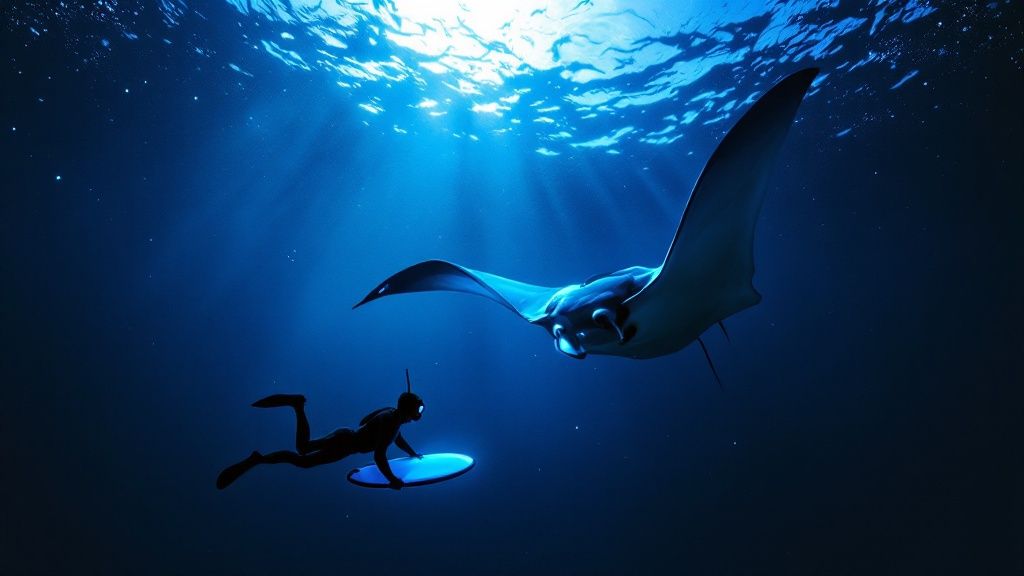
Imagine this: you're floating weightlessly in the calm, dark Pacific Ocean. Suddenly, majestic manta rays, with wingspans stretching over 12 feet, begin to glide and dance in the beams of light just inches below you. This isn't a dream—it's the unforgettable magic of the manta ray night snorkel in Kona, an experience that makes it the world's best spot for this bucket-list wildlife encounter.
Your Ultimate Guide to Kona's Manta Ray Night Snorkel
This guide is your complete roadmap to experiencing this incredible spectacle for yourself. As the top rated & most reviewed snorkel company in Hawaii, Kona Snorkel Trips is here to cover everything you need to know, from preparation to what happens on the water, to make sure your adventure is safe, respectful, and absolutely breathtaking.
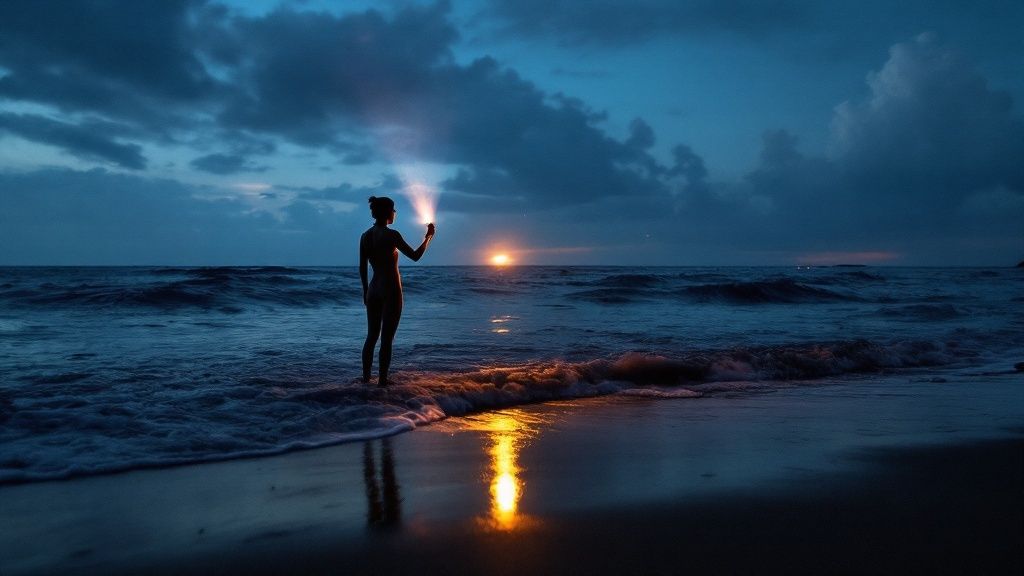
The Big Island's Kona coast offers one of the most reliable and awe-inspiring wildlife encounters on the planet. Unlike a lot of marine adventures where a sighting is pure luck, seeing mantas here is remarkably consistent. This has turned a quiet stretch of coastline into a global hotspot for ocean lovers.
This incredible reliability is no accident. Night snorkel tours along the Kona Coast have a ridiculously high success rate, typically somewhere between 85% to 90%. That makes it one of the most dependable places in the world to see these gentle giants, attracting around 80,000 visitors every single year.
What Makes This Experience So Unique?
The magic behind it all is a simple, yet brilliant, setup. Tour operators shine powerful, submerged lights into the water. These lights attract massive clouds of phytoplankton—the tiny organisms that form the very foundation of the ocean's food web.
For the manta rays, this concentration of plankton is an all-you-can-eat buffet they just can't resist. The result is a mesmerizing underwater ballet, as these giants perform graceful barrel rolls and swoops while they feed, sometimes coming within inches of you.
It's a completely passive experience. Snorkelers hold onto a custom-designed floatation board that has lights built into it, so it’s accessible even if you're not a strong swimmer.
The feeling of a 12-foot manta ray gliding silently beneath you, its massive wings nearly brushing your fins, is an experience that stays with you forever. It's a profound connection with one of the ocean's most majestic animals.
This isn't just a tour; it's an immersion into a natural phenomenon that has been perfected over decades. For a truly deep dive, check out this complete adventure guide to Manta Ray Night Dive Kailua Kona.
Ready to witness this natural wonder for yourself? The first step is locking in your spot with a top-tier operator.
Why Kona is the Manta Ray Capital of the World
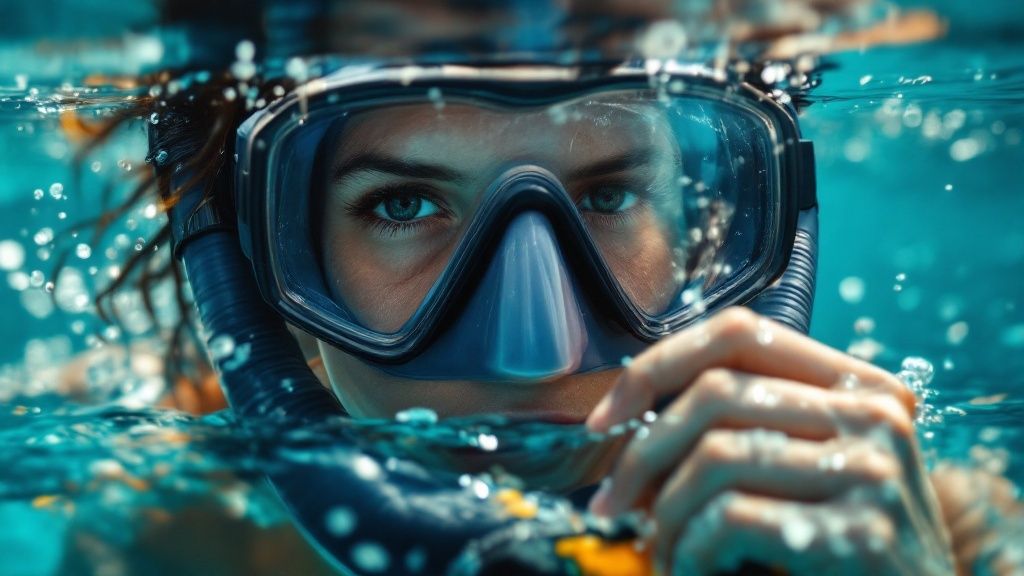
So, what makes the manta ray night snorkel here a global phenomenon? It's not just blind luck. It’s a perfect storm of unique geography, predictable biology, and a little bit of clever human thinking. The Kona coast is, simply put, built differently.
It all starts with phytoplankton—the microscopic critters that manta rays love to eat. The underwater landscape here, shaped by ancient lava flows, has created natural coves and steady currents that act like a funnel, concentrating the plankton. This makes the area a reliable, all-you-can-eat buffet for these gentle giants.
Decades ago, tour operators figured out how to turn this natural attraction into a near-guaranteed spectacle. The idea is brilliant in its simplicity, often described as creating an "underwater campfire."
The Science of the Spectacle
Tour boats head out to known manta feeding spots and drop anchor. Once they're set, they sink powerful lights into the dark water. Just like moths to a flame, these lights attract massive clouds of plankton, pulling them up from the depths and creating a dense, irresistible feast.
For the manta rays, this is an easy meal they simply can't ignore. They swim right into the beams of light to feed, performing their famous, graceful barrel rolls to gulp down as much plankton as possible. This simple method is what makes the manta ray night snorkel Kona experience so consistently amazing, night after night.
The Kona Coast is also home to a thriving and well-studied population of reef mantas. The resident group is estimated to include over 450 individual rays, and researchers are cataloging about 120 new ones every year. This incredible abundance is a direct result of our unique oceanic conditions.
Kona's Premier Manta Ray Viewing Locations
While you can spot mantas along the coast, the night snorkel tours focus on a few key spots where sightings are most reliable. These "stages" for the nightly ballet have become world-famous.
- Manta Village (Keauhou Bay): This is the original and most famous site, just south of Kailua-Kona. Tucked inside a protected bay, it's almost always calm. The lights from a nearby resort first attracted the mantas here decades ago, establishing it as a prime feeding ground.
- Manta Heaven (Garden Eel Cove): Located north of Kona near the airport, this spot is another major hotspot. It can sometimes have a bit more current, but it's known for attracting huge numbers of mantas for a slightly different but equally breathtaking show.
The reliability of these sites is what truly sets Kona apart. It’s not just about seeing a manta ray; it’s about witnessing a whole community of them feeding naturally in a predictable, accessible, and respectful way.
The entire operation is a finely tuned event, from the plankton to the mantas to the tour guides who make the encounter possible. And while the manta experience is truly one-of-a-kind, the Kona coast has so much more to see. Check out our guide on the best snorkeling in Kona for other amazing underwater adventures.
Understanding the "why" behind this encounter gives you a much deeper appreciation for the magic you're about to witness before you even get your feet wet.
How to Choose the Right Manta Ray Snorkel Tour
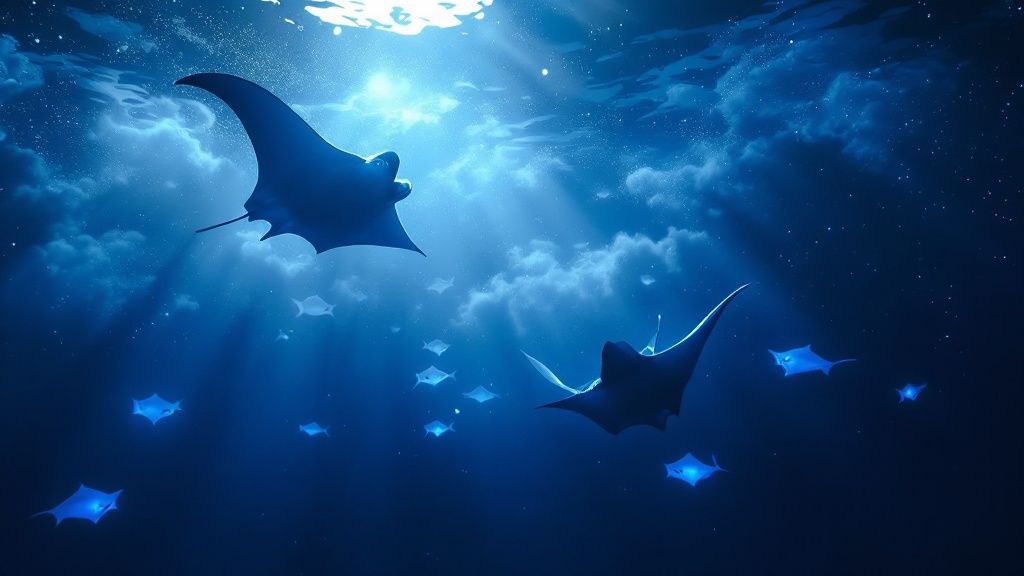
Picking the right operator for your manta ray night snorkel in Kona is probably the single most important choice you'll make. It’s what separates a decent trip from a truly life-changing memory you'll talk about for years. The big differentiators come down to boat size, how many people they pack on board, their safety record, and a real, genuine commitment to protecting the mantas.
Let's be clear: not all tours are created equal. Some outfits run huge boats that feel like a party barge, while others focus on intimate, small-group adventures. The path you choose will completely shape your experience in the water.
Group Size and Boat Type
The number of people on your tour completely changes the vibe. I've found that smaller boats almost always deliver a more personal, relaxed, and special adventure. It just feels different.
With a smaller crowd, you actually get to talk to your guides. You can ask all the questions you want and get real answers. This is a game-changer if you're a first-timer or have kids who might need a little extra reassurance before jumping into the dark ocean.
Here's the inside scoop: a smaller tour group means less chaos at the manta viewing site. You get a front-row, unobstructed view of the action instead of fighting for a spot. It's a much more peaceful and profound way to connect with these incredible animals.
A top-tier outfit like the Kona Snorkel Trips manta ray tour builds its whole experience around this small-group philosophy. They make sure every single person feels like a VIP, which is exactly how it should be.
When you're shopping around, Manta Ray Night Snorkel Hawaii is an exceptional alternative known for quality service and a fantastic Manta Ray night snorkel tour.
Safety and Eco-Conscious Practices
Nothing is more important than your safety. A reputable company will have a spotless safety record, period. Their guides and captains will be highly trained and certified professionals who know these waters like the back of their hand. They'll give you a thorough safety briefing and make sure every piece of gear, from your wetsuit to your float belt, is in perfect shape.
Just as critical is the company's dedication to protecting the manta rays. Responsible operators are sticklers for the rules that keep the mantas safe and comfortable. This isn't optional.
Look for companies that enforce:
- A strict no-touching policy: Manta rays have a protective mucus coating on their skin. Touching them can damage this layer and make them vulnerable to infection.
- Proper positioning in the water: Good guides will teach you how to float passively on the surface, giving the mantas plenty of room to come up and feed naturally without feeling threatened.
- Educational briefings: The best tours don't just show you mantas; they teach you about them. You'll learn about their biology and why conservation is so vital, making the whole experience much richer.
When you choose a tour that takes these things seriously, you’re not just ensuring a better, closer encounter for yourself—you’re helping protect this amazing natural spectacle for everyone who comes after you.
Comparing Kona Manta Ray Tour Options
So, what's the right fit for you? To help you visualize the difference, here's a quick comparison of what you can generally expect from the two main types of tours.
| Feature | Small Group Tours (e.g., Kona Snorkel Trips) | Large Group Tours |
|---|---|---|
| Guest Experience | Highly personalized with more guide interaction. | Less individual attention; can feel more crowded and anonymous. |
| Boat Atmosphere | Relaxed, intimate, and often feels like a private charter. | More bustling and energetic, similar to a larger excursion. |
| Water Time | Easier entry and exit from the water, with more space at the light board. | Can be crowded at the viewing area, potentially limiting views. |
| Ideal For | Families, couples, first-timers, and anyone seeking a premium experience. | Budget-conscious travelers or those who enjoy a lively group dynamic. |
| Booking | Tends to book up far in advance due to limited capacity. | More availability, but still wise to book ahead. |
At the end of the day, picking a trusted, top-rated company lets you stop worrying and just soak in the magic of the moment. By thinking about these key factors, you can book your manta ray night snorkel Kona adventure with confidence, knowing it will be safe, comfortable, and absolutely unforgettable.
Ready to book an incredible small-group experience?
Preparing for Your Night Snorkel Adventure
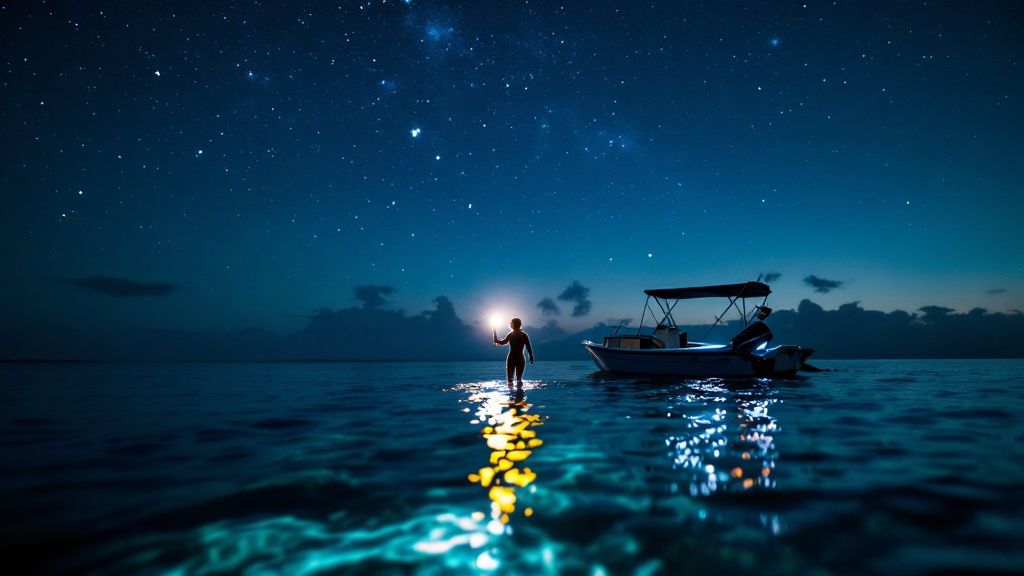
The key to a truly unforgettable manta ray night snorkel in Kona is feeling prepared. When you know exactly what to bring and what to expect, you can let go of any pre-trip jitters and just soak in the excitement. This guide will walk you through everything, so you arrive at the dock confident and ready for the magic to begin.
The best part? Professional tour operators provide all the specialized gear you'll need to stay safe, warm, and comfortable in the water. No need to buy or lug around a bunch of bulky equipment.
What Your Tour Operator Provides
Any reputable company puts your safety and comfort first. When you book a tour, you can count on being outfitted with high-quality, sanitized gear that's essential for the experience.
- Wetsuits: The ocean gets surprisingly chilly after the sun goes down, even here in Hawaii. A properly fitted wetsuit is a game-changer, keeping you warm and buoyant for the whole trip.
- Mask, Snorkel, and Fins: Professional-grade gear means you get a crystal-clear view of the mantas without battling a leaky or foggy mask.
- Flotation Devices: You won't be swimming around on your own. Instead, you'll hold onto a custom-built, floating light board. This board not only lights up the water to attract the plankton that mantas feed on, but it also gives you a stable and secure handhold.
That shared flotation board is a core part of the experience. It keeps the group together, gives everyone a front-row seat, and lets you completely relax. All you have to do is focus on the incredible underwater ballet happening right below you.
Your Personal Packing Checklist
While the tour company handles the main equipment, a few personal items will make your adventure that much smoother from start to finish. Think of this as your go-to list for a perfect night.
- Arrive Ready to Snorkel: The simplest trick is to wear your swimsuit under your clothes. It saves you the hassle of changing in the tight quarters of a boat.
- A Warm Towel: You will be so grateful for a big, fluffy towel to wrap up in the moment you climb out of the water.
- Dry Change of Clothes: The boat ride back to the harbor can feel brisk after being in the ocean. Having a dry shirt, shorts, or a hoodie to change into will keep you cozy.
- Underwater Camera (Optional): If you've got a GoPro or a similar waterproof camera, now's the time to use it! Just be sure to turn off your flash, as bright lights can disturb the mantas.
- Reusable Water Bottle: Staying hydrated is always a good move. Plus, many eco-conscious tour operators appreciate it when you bring your own bottle.
Addressing Common Pre-Tour Worries
It’s totally normal to have a few questions floating around in your head before you go, especially if it’s your first time snorkeling at night. Let's tackle the most common ones.
First up: seasickness. If you know you're prone to motion sickness, it’s a smart move to take a non-drowsy medication like Dramamine or Bonine about an hour before you get on the boat. That gives it plenty of time to kick in.
The other big question is about swimming ability. Here’s one of the best things about this tour: strong swimming skills are not required. Because you just hold onto the floating light board, you can relax and watch the show without having to tread water. This makes the manta ray night snorkel Kona experience incredibly accessible to almost everyone.
To feel even more confident in the water, take a look at these essential snorkeling safety tips.
By following this simple checklist and knowing how the tour is set up, you can put any worries to rest and get ready for one of the most breathtaking wildlife encounters on Earth.
What to Expect During Your Manta Ray Encounter
The whole experience kicks off the moment you step on the boat. Your trip out to see the mantas starts with a jaw-dropping ride along the Kona coastline just as the sun begins to melt into the horizon. The sky explodes with color—it's the perfect opening act for the main event.
Once the boat anchors at one of the world-famous manta spots, you can feel the energy shift. The relaxed sightseeing cruise turns into buzzing excitement. Your crew will pull everyone together for a solid safety briefing, walking you through exactly how the night will play out, from slipping into the water to how to hang out with the mantas without stressing them out.
Pay close attention here. The guides will show you how to hold onto the floating light board, which is kind of your home base in the water. It helps you float and, more importantly, it's the beacon that attracts the manta's dinner. They'll drill you on the golden rule of the encounter: be a passive observer. That means no touching, no chasing, and definitely no diving down after them.
The Magic Begins
Once the briefing's done, it's go-time. The crew flips on the powerful underwater lights, and the dark ocean beneath you instantly transforms into a glowing, ethereal blue-green stage. Right away, you’ll see tiny specks dancing in the light beams—that's the plankton, the microscopic buffet that brings the mantas to the party.
Then comes the waiting. The feeling is electric. You scan the dark edges of the light, and then… you see it. A massive, graceful shadow gliding up from the deep. That first glimpse of a manta ray is a genuine heart-stopper that usually makes the whole boat go silent.
As you slide into the water and find your spot at the light board, you're front-row for one of nature’s most incredible shows. The mantas, drawn in by the thick cloud of plankton, start their underwater ballet. They perform these effortless "barrel rolls," swooping up from below with their mouths wide open to filter out the plankton.
The sheer size of these animals is something you just can't grasp from photos. They glide by silently, sometimes coming within inches of you, and you can feel the water move as their enormous fins pass. It’s a humbling, peaceful, and totally mesmerizing experience.
Your only job is to float, watch, and let your jaw drop. By staying still and calm, you let the mantas know you're not a threat, which encourages them to come right up to the lights and feed naturally.
We're talking about giant mantas, some with wingspans over 12 feet, in pretty shallow water around 30-40 feet deep. This setup allows for a good, long look—usually between 45-60 minutes in the water. The crazy high success rate and the spectacle of seeing a dozen mantas at once is what's made this a world-renowned experience. You can get more details about the Kona manta ray night dive encounters on Kona Honu Divers' site.
The entire thing is carefully managed to be as incredible for you as it is safe and respectful for the mantas. When your time is up, you'll climb back on the boat, buzzing with adrenaline and awe, for a warm drink and a cruise back to the harbor under the stars. It's an adventure from sunset to starlight that you'll be talking about for years.
Ready for this incredible encounter?
Answering Your Top Manta Ray Snorkel Questions
Even as the excitement builds, it's totally normal to have a few questions popping into your head before you commit to an adventure like the manta ray night snorkel in Kona. Getting straight answers helps you feel confident and ready to go when you show up at the boat.
We've been asked just about everything by first-timers and seasoned snorkelers alike. So, we've gathered the most common questions right here to give you all the details you need, from the best time of year to visit to the golden rules of swimming with these gentle giants.
When Is the Best Time of Year to See Manta Rays in Kona?
This is easily the question we hear most, and the answer is fantastic news for anyone planning a trip. The manta ray night snorkel in Kona is an amazing year-round activity with an incredible success rate that often tops 90%.
Unlike migratory animals like humpback whales, Kona's manta rays are residents. They live here full-time because their main food source—plankton—is always on the menu. This means you have an excellent shot at a spectacular encounter no matter which month you book.
That said, if you're trying to line up the absolute best conditions, a lot of people love visiting between April and October. During these months, the ocean is usually at its calmest and the water is warmest. The winter can sometimes bring bigger swells, but because the tours operate out of protected bays, we still see incredible manta action every single night of the year.
The bottom line is simple: there’s no "bad" time to see the mantas in Kona. The best time to go is whenever you can get here.
Is This Tour Safe if I am Not a Strong Swimmer?
Yes, absolutely. This experience was designed from the ground up to be safe, comfortable, and accessible for people of all swimming abilities. You won't be asked to swim around freely in the dark, open ocean.
Instead, everyone holds onto a large, custom-made light board that floats on the surface. You just lay on your stomach, hang on, and watch the incredible show happening in the light beams right below you. It's that easy.
Your tour provides all the gear you need to feel secure, including:
- Buoyant Wetsuits: These don't just keep you warm; they add extra flotation, helping you relax completely in the water.
- Flotation Belts or Vests: For anyone who wants a little extra peace of mind, these are always available.
- Professional In-Water Guides: Trained guides are right there in the water with you the entire time, making sure everyone feels safe and comfortable from start to finish.
Will I Get Cold in the Water at Night?
This is a totally fair question. We get it, night swimming sounds chilly! But the tour operators in Kona are pros at keeping guests comfortable for the whole trip.
You’ll be given a high-quality wetsuit that does a great job of insulating you from the cooler night water. The ocean temperature around Kona actually stays pretty warm year-round, usually hovering in the mid-to-high 70s Fahrenheit (around 24-26°C).
Between the cozy wetsuit and the pure adrenaline of watching giant manta rays glide inches beneath you, most people find they are perfectly comfortable for the entire 45-minute in-water portion of the tour.
Are We Allowed to Touch the Manta Rays?
No, and this is the single most important rule of the encounter: touching the manta rays is strictly forbidden. Every reputable tour company enforces a "passive observation" policy to protect these incredible animals.
Manta rays have a delicate, protective mucus coating on their skin. Think of it as their immune system—it shields them from harmful bacteria and infections. Touching them, even with the lightest finger, can rub off this slime coat and make them vulnerable to disease.
By just floating and watching, we ensure the mantas feel safe and comfortable enough to come right up to the lights to feed. This respectful approach not only protects these gentle giants but also leads to a much closer and more authentic experience for everyone. And while they are related to stingrays, it’s good to know that manta rays are completely harmless. To learn more, check out our detailed article explaining if manta rays can sting you.
Hopefully, answering these key questions helps you feel fully prepared for one of the most memorable wildlife encounters on the planet.
Ready for an unforgettable adventure? Kona Snorkel Trips, Hawaii's highest-rated and most-reviewed snorkel company, offers an exceptional small-group manta ray night snorkel tour that will be the highlight of your vacation.
